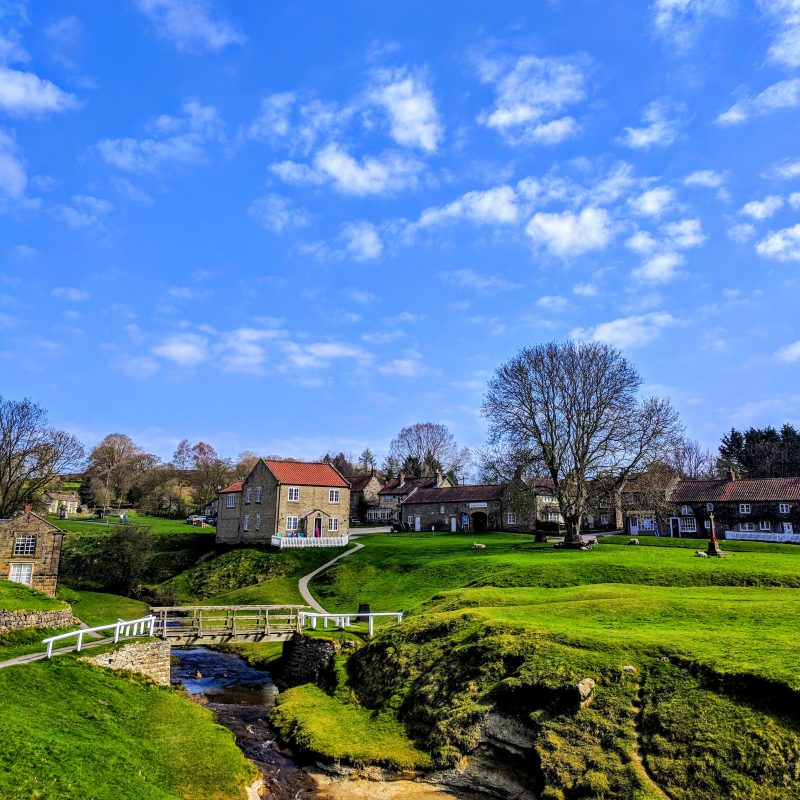Hutton-le-Hole

Why we love HUTTON-LE-HOLE
The sheep, the picket fences, the beautiful beck, the gorgeous cottages, the folk museum…the list goes on!
Where:
Located on the edge of the Moors, just inside the boundary of the North York Moors National Park, Hutton-le-Hole has long been regarded as one of the UK’s most idyllic villages.
A narrow beck winds through the length of the village, dissecting the long village green, alongside which you’ll find grazing sheep or sunbathing picnickers – and quite often both! The huge walnut tree in the middle of the village provides shelter from the sunshine and rain that can often be experienced on the same day. At the top of Hutton-le-Hole’s village green is the old schoolhouse, a charming building that is now a café; the last lessons were taught here in the mid-1990s.
History:
Despite the relatively small size of the village, Hutton-le-Hole boasts 29 listed buildings, most dating back to the late 18th century. There’s a 17th century ‘pound’ across the road from the old schoolhouse, built to hold lost sheep.
An 18th century boundary stone at the northern edge of the village bears the inscription ‘T.D’, a reference to Thomas Duncombe, the former Lord of the Manor of nearby Helmsley. The boundary stone is known as “Hangman Stone” because, according to folklore, it is where a thief met a gruesome end. The local legend recalls that the thief had stolen a sheep, which his was carrying back to Hutton-le-Hole on his back, with the sheep’s hind legs strapped together and hoisted around the thief’s neck. The thief was tired from carrying the sheep across the Moors and as he reached the village, he leant against the boundary stone to rest, but the sheep slipped back which hanged the thief astride the stone.
The Victorian’s are said to have held Hutton-le-Hole in fairly low esteem – the village is described as “ill-planned and untidy” in Victorian records. Aside from liking a bit of order to the layout of town or village (something that Hutton-le-Hole definitely does not have), the reason for Hutton-le-Hole’s poor reputation during Victorian times may just be that the village was where miners were living and boarding while working out in the iron-ore mines that had sprung up across the Moors near Hutton-le-Hole and Rosedale.
Today:
Popular with families stopping for a picnic alongside Hutton Beck and with cyclists and walkers heading for the Moors, Hutton-le-Hole hasn’t lost any of its historic charm. Governed by a ‘court leet’, you’ll regularly find a flock of sheep grazing on the common land – which means that every house needs to have a good fence and secure gate around the entire property, just to stop the sheep getting into each garden to eat all the flowers and vegetables!
Ryedale Folk Museum
With a wealth of preserved traditional buildings, rescued and restored from the local area, the Ryedale Folk Museum offers a real insight into life in this part of Yorkshire from the early medieval period to the Victorian age and Industrial Revolution. There’s an Elizabethan Manor, a number of thatched cottages, shops, barns and workshops.
The museum opens from March – November every year – visit www.ryedalefolkmuseum.co.uk for more information.
Origin of the name:
One of the many places whose origin is in dispute, Hutton could simply be “the high place [Hutton] in the hollow [le-Hole, from Norman-French]”. However, the ‘hole’ part of the name could instead be a reference to the several ancient burial mounds found nearby – “the high place near the burial grounds” is therefore quite plausible.
Tours:
We visit or travel through Hutton-le-Hole on several of our day trips from York:
- Steam Trains,Whitby & the Moors
- York & Yorkshire in a day
- Afternoon & Evening in the Moors
- Whitby, Goathland & the Moors
- A Taste of the Moors (details coming soon)
Where to eat:
The Forge Tea Rooms & Ice Cream Parlour
The Crown
Where to go for a coffee:
The Forge Tea Rooms & Ice Cream Parlour
Where to go for a drink:
Where to stay:
What to see:
The village itself is the attraction – just have a stroll around and see the sheep who roam free through Hutton-le-Hole.
The Ryedale Folk Museum – www.ryedalefolkmuseum.co.uk
